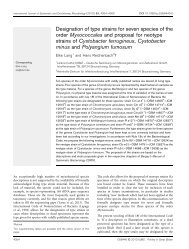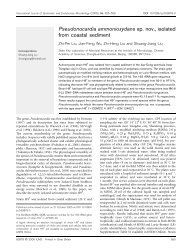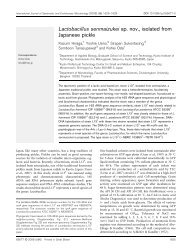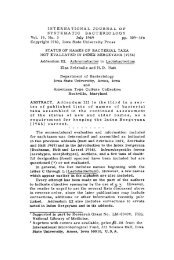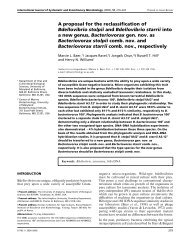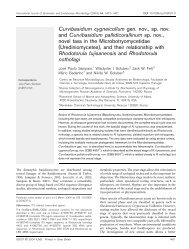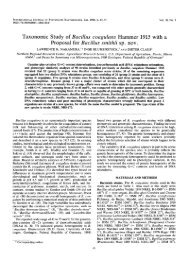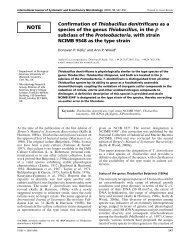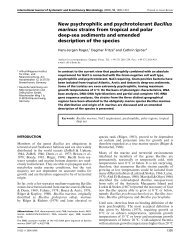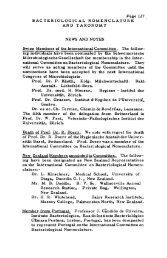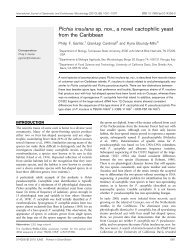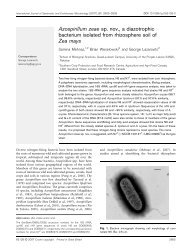Stenotrophomonas acidaminiphila sp. nov., a strictly aerobic ...
Stenotrophomonas acidaminiphila sp. nov., a strictly aerobic ...
Stenotrophomonas acidaminiphila sp. nov., a strictly aerobic ...
Create successful ePaper yourself
Turn your PDF publications into a flip-book with our unique Google optimized e-Paper software.
International Journal of Systematic and Evolutionary Microbiology (2002), 52, 559–568 DOI: 10.1099/ijs.0.01869-0<br />
1 De partement de<br />
Biochimie-Microbiologie,<br />
Faculte des Sciences et<br />
Techniques, Universite de<br />
Ouagadougou, 03 BP 7021,<br />
Ouagadougou 03, Burkina<br />
Faso<br />
2 Departamento de<br />
Biotecnologıa, Universidad<br />
Auto noma Metropolitana-<br />
Iztapalapa, Avenida<br />
Michoaca n y la Purisima<br />
s/n, Col. Vicentina, 09340<br />
Me xico DF, Mexico<br />
3 Institut de Recherche pour<br />
le De veloppement (IRD),<br />
Cicero n 609, Col. Los<br />
Morales, 11530 Me xico DF,<br />
Mexico<br />
4 Laboratoire de<br />
Microbiologie IRD, IFR-<br />
BAIM, Universite sde<br />
Provence et de la<br />
Me diterrane e, ESIL case<br />
925, 163 avenue de<br />
Luminy, 13288 Marseille<br />
cedex 9, France<br />
INTRODUCTION<br />
An<strong>aerobic</strong> digesters are complex, man-made biotopes,<br />
used for treatment of wastewater, sludge and organic<br />
solids, where both <strong>strictly</strong> an<strong>aerobic</strong> and <strong>aerobic</strong><br />
bacteria can co-exist (Guyot et al., 1994; Noeth et al.,<br />
1988; Toerien & Hattingh, 1969). Surveys of bacterial<br />
population types have revealed the presence, in these<br />
.................................................................................................................................................<br />
Abbreviations: CFA, cellular fatty acid; UASB, upflow an<strong>aerobic</strong> sludge<br />
blanket.<br />
The GenBank/EMBL/DDBJ accession number for the 16S rRNA gene<br />
sequence of strain AMX 19T is AF273080.<br />
<strong>Stenotrophomonas</strong> <strong>acidaminiphila</strong> <strong>sp</strong>. <strong>nov</strong>., a<br />
<strong>strictly</strong> <strong>aerobic</strong> bacterium isolated from an<br />
upflow an<strong>aerobic</strong> sludge blanket (UASB)<br />
reactor<br />
Essokazi A. Assih, 1 Aboubakar S. Ouattara, 1 Se bastien Thierry, 2,3<br />
Jean-Luc Cayol, 4 Marc Labat 4 and Herve Macarie 2,3<br />
Author for corre<strong>sp</strong>ondence: Aboubakar S. Ouattara. Tel: 226 33 73 73. Fax: 226 33 73 73.<br />
e-mail: ouattabsuniv-ouaga.bf<br />
Two of several <strong>strictly</strong> <strong>aerobic</strong>, mesophilic bacteria isolated from a lab-scale<br />
upflow an<strong>aerobic</strong> sludge blanket (UASB) reactor treating a petrochemical<br />
wastewater, strains AMX 17 and AMX 19 T , were subjected to detailed<br />
taxonomic study. Cells were Gram-negative, motile, non-<strong>sp</strong>orulating, straight<br />
to curved rods with a polar flagellum. The isolates exhibited phenotypic traits<br />
of members of the genus <strong>Stenotrophomonas</strong>, including cellular fatty acid<br />
composition and the limited range of substrates that could be used. Sugars<br />
and many amino acids were utilized. Antibiotic susceptibility and physiological<br />
characteristics were determined. The DNA base composition was 669 mol%<br />
GMC. Phylogenetic analysis revealed that the nearest relatives were<br />
<strong>Stenotrophomonas</strong> maltophilia LMG 11114, <strong>Stenotrophomonas</strong> nitritireducens<br />
DSM 12575 T and Pseudomonas pictorum ATCC 23328 T (similarity of 981–988%).<br />
Xanthomonas <strong>sp</strong>ecies, S. maltophilia LMG 958 T and <strong>Stenotrophomonas</strong> africana<br />
CIP 104854 T showed high 16S rRNA sequence similarities (964–973%). The high<br />
similarity found in cellular fatty acid profiles and identical partial 16S rRNA<br />
sequences (500 bp) for strains AMX 17 and AMX 19 T indicate that they belong<br />
to the same <strong>sp</strong>ecies. DNA–DNA hybridizations revealed re<strong>sp</strong>ectively 267, 31,<br />
658 and 436% homology between isolate AMX 19 T and S. africana CIP 104854 T ,<br />
S. maltophilia CIP 60.77 T , S. nitritireducens DSM 12575 T and P. pictorum ATCC<br />
23328 T . These results allow the proposal of strain AMX 19 T ( DSM 13117 T <br />
ATCC 700916 T CIP 106456 T ) as representative of a <strong>nov</strong>el <strong>sp</strong>ecies of the genus<br />
<strong>Stenotrophomonas</strong>, with the name <strong>Stenotrophomonas</strong> <strong>acidaminiphila</strong> <strong>sp</strong>. <strong>nov</strong>.<br />
Keywords: polyphasic taxonomy, cellular fatty acids, amino acids, an<strong>aerobic</strong> reactor,<br />
Xanthomonas<br />
ecosystems, of <strong>aerobic</strong>, non-<strong>sp</strong>orulating, Gram-negative,<br />
flagellated, chemo-organotrophic proteobacteria<br />
that possess a <strong>strictly</strong> re<strong>sp</strong>iratory energy-yielding<br />
metabolism (Britz et al., 1994; Hakulinen et al., 1985;<br />
Ng et al., 1994; Toerien & Hattingh, 1969). A wide<br />
diversity of genera, including <strong>Stenotrophomonas</strong>, are<br />
members of this heterogeneous group with versatile<br />
metabolisms. Initially containing a single <strong>sp</strong>ecies,<br />
<strong>Stenotrophomonas</strong> maltophilia, the number of <strong>sp</strong>ecies<br />
of the genus <strong>Stenotrophomonas</strong> has increased to three<br />
with the recent characterization and description of<br />
<strong>Stenotrophomonas</strong> africana (Drancourt et al., 1997)<br />
and <strong>Stenotrophomonas</strong> nitritireducens (Finkmann et<br />
01869 2002 IUMS Printed in Great Britain 559
E. A. Assih and others<br />
al., 2000). The original member of the genus, S.<br />
maltophilia, originally isolated from human pleural<br />
fluid and named ‘Bacterium bookerii’, was validly<br />
described as Pseudomonas maltophilia (Hugh & Ryschenkow,<br />
1961) before being renamed Xanthomonas<br />
maltophilia on the basis of quinone type, cellular fatty<br />
acid (CFA) composition, enzyme characterization and<br />
DNA–rRNA hybridization results (Swings et al.,<br />
1983). However, the affiliation of P. maltophilia to the<br />
genus Xanthomonas was subject to criticism (Van Zyl<br />
& Steyn, 1992), and a further reclassification of X.<br />
maltophilia to S. maltophilia was proposed (Palleroni<br />
& Bradbury, 1993).<br />
This <strong>sp</strong>ecies has been the object of several taxonomic<br />
studies (Hauben et al., 1999; Moore et al., 1997;<br />
Palleroni & Bradbury, 1993; Stanier et al., 1966; Van<br />
den Mooter & Swings, 1990; Vauterin et al., 1995;<br />
Wang et al., 1998). <strong>Stenotrophomonas</strong> <strong>sp</strong>ecies are<br />
common inhabitants of a wide variety of natural and<br />
artificial environments such as water, sediments, plant<br />
rhizo<strong>sp</strong>heres, corroded metal surfaces, waste-gas biofilters,<br />
aquaculture tanks, oilfields, sewage and an<strong>aerobic</strong><br />
reactors (Aznar et al., 1992; Boonchan et al.,<br />
1998; Borowicz et al., 1995; Britz et al., 1994;<br />
Finkmann et al., 2000; Hauben et al., 1999; Juhnke et<br />
al., 1987; Lambert et al., 1990; Leifert & Waites, 1992;<br />
Wallace et al., 1994; Wilkinson et al., 1994) and can be<br />
opportunistic human pathogens (Drancourt et al.,<br />
1997; Denton & Kerr, 1998).<br />
In an attempt to determine the role of <strong>strictly</strong> <strong>aerobic</strong><br />
bacteria in an<strong>aerobic</strong> digesters, enumeration and<br />
identification of these micro-organisms was performed<br />
from a laboratory-scale upflow an<strong>aerobic</strong> sludge blanket<br />
(UASB) reactor fed with the wastewater of a petrochemical<br />
company producing purified terephthalic<br />
acid (1,4-benzenedicarboxylic acid). Several strains<br />
were isolated and subjected to identification by classical<br />
biochemical character determination, CFA composition<br />
analysis andor partial 16S rRNA sequence<br />
analysis. Most of the isolates could be identified<br />
accurately by the set of taxonomic tools but some were<br />
not readily identifiable. Among this last group of<br />
micro-organisms, several strains, AMX strains 15, 17,<br />
18, 19T and 312, could be arranged in the same cluster<br />
based on their CFA profiles. Strains AMX 17 and<br />
AMX 19T were then subjected to more detailed taxonomic<br />
study. We report the characterization of strains<br />
AMX 17 and AMX 19T as a <strong>nov</strong>el <strong>sp</strong>ecies of the genus<br />
<strong>Stenotrophomonas</strong>, <strong>Stenotrophomonas</strong> <strong>acidaminiphila</strong><br />
<strong>sp</strong>. <strong>nov</strong>., with strain AMX 19T ( DSM 13117T <br />
ATCC 700916T CIP 106456T) as the type strain.<br />
METHODS<br />
Source of organisms. Strains AMX 17 and AMX 19T were<br />
isolated from the an<strong>aerobic</strong> sludge of a laboratory-scale<br />
UASB reactor using R2A medium (Oxoid). The reactor, fed<br />
with settled, genuine, terephthalic-acid-plant wastewater<br />
supplemented with nitrogen, pho<strong>sp</strong>horous, sulfur and trace<br />
metals, was operated at a constant organic loading rate of<br />
225 g COD l−<br />
reactor day− [01 g COD (g VSS)− day−] (COD,<br />
chemical oxygen demand; VSS, volatile su<strong>sp</strong>ended solids)<br />
and a hydraulic retention time of 2 days. The temperature in<br />
situ averaged 33 C and the pH was near 74. The main<br />
organic compounds present in the wastewater were acetic,<br />
benzoic, p-toluic (4-methylbenzoic), trimellitic (1,2,4-benzenetricarboxylic)<br />
and terephthalic acids, as well as 4carboxybenzaldehyde<br />
(4-formylbenzoic acid) and ethylene<br />
glycol (Fajardo et al., 1997). By the time of isolation, the<br />
reactor was fed with non-sterilized wastewater and could be<br />
considered in stationary phase, since it presented constant<br />
biogas production (108 l day− at 1 atm, 0 C) and COD<br />
removal (806%). Purifications were performed by streaking<br />
colonies onto Petri dishes containing medium R2A or<br />
plate count agar (Difco). The purity of isolates was checked<br />
in a complex medium containing 05% yeast extract, 05%<br />
peptone, 05% Bio-trypticase, 05% Casamino acids and<br />
025% glucose. The culture was examined microscopically<br />
after 1–3 weeks of incubation. S. maltophilia CIP 60.77T and<br />
S. africana CIP 104854T were obtained from the Collection<br />
de l’Institut Pasteur (CIP), S. nitritireducens DSM 12575T<br />
was from the DSMZ and P. pictorum ATCC 23328T was<br />
from the ATCC.<br />
Media and culture conditions. With the exception of the<br />
isolation and purification procedures, all procedures were<br />
performed in liquid medium using standard techniques for<br />
cultivation of strict aerobes. For nutritional tests, strains<br />
were grown on a basal medium containing (l−): 025 g<br />
KH PO , 030 g NH Cl, 1 g NaCl, 050 g KCl, 040 g<br />
MgCl<br />
<br />
.6H<br />
<br />
O, 016 g<br />
<br />
CaCl .2H O and 010 g Casamino<br />
acids.<br />
<br />
Media<br />
<br />
were di<strong>sp</strong>ensed<br />
<br />
into tubes or flasks and<br />
sterilized at 120 C for 18 min. Just before inoculation,<br />
substrates (sugars, organic acids or amino acids) were<br />
supplied from filter-sterilized stock solutions in order to<br />
reach a final concentration of 10 mM, except for the<br />
aromatic amino acids, which were added at 1 g l−, and the<br />
racemic mixtures, which were prepared at 20 mM.<br />
Determination of optimal growth conditions (pH, temperature)<br />
was conducted in a rich culture medium (basal<br />
medium supplemented with 5 g Casamino acids and 2 g<br />
yeast extract l−). The pH was fixed at 7 when testing<br />
temperature and the temperature at 35 C when testing pH.<br />
Growth was monitored by measuring the optical density at<br />
580 nm. The ranges tested for growth were pH 50–95 and<br />
4–50 C.<br />
General phenotypic characteristics. Phenotypic characterization<br />
of isolate AMX 19T was based on Gram staining,<br />
motility, re<strong>sp</strong>iratory, catalase and oxidase tests (Diagnostics<br />
Pasteur). Further biochemical analysis was performed by<br />
inoculating API 20 NE and API 50 CH strips (bioMe rieux)<br />
according to the manufacturer’s instructions. The cell<br />
morphology was determined from direct observations of<br />
fresh cultures using a Nikon phase-contrast microscope or<br />
exponentially grown cells negatively stained with 1% sodium<br />
pho<strong>sp</strong>hotungstic acid (pH 72) with a Hitachi model<br />
H600 transmission electron microscope operated at an<br />
accelerating voltage of 75 kV. The presence, number and<br />
position of flagella were determined both by flagellar staining<br />
and by electron microscopy.<br />
Antibiogram. Susceptibility of strain AMX 19T to 15<br />
antibiotics was tested by Pasteur Cerba (Paris, France) using<br />
the Kirby–Bauer disk-diffusion method (Bauer et al., 1966)<br />
on Mueller–Hinton solid medium (l−: 3 g beef infusion,<br />
175 g Casamino acids, 15 g starch, 17 g agar). Inhibition<br />
diameters were recorded after 24 h of incubation at 37 C<br />
560 International Journal of Systematic and Evolutionary Microbiology 52
under <strong>aerobic</strong> conditions. The classification of each strain as<br />
sensitive, not sensitive or intermediately sensitive to the<br />
antibiotic was done according to the disk manufacturer’s<br />
instructions (Sanofi Diagnostics Pasteur), based on the<br />
directives of the French antibiogram committee (Comite de<br />
l’antibiogramme de la Socie te Franc aise de Microbiologie,<br />
1997). The antibiotics tested corre<strong>sp</strong>ond to those presently<br />
recommended for Pseudomonas aeruginosa and other Gramnegative<br />
aerobes. They cover the different mechanisms of<br />
antibiotic action (inhibition of synthesis of peptidoglycan,<br />
proteins, nucleic acids and folate and disruption of membranes).<br />
CFA analysis. The CFA compositions of strains AMX 17 and<br />
AMX 19T and also those of collection strains were determined<br />
by Microbial ID, Inc., using the Sherlock Microbial<br />
Identification System software (MIDI Inc.). Prior to<br />
analysis, reference strains and isolates were cultivated in<br />
trypticase soy broth agar at 28 C for 24 h. CFA were<br />
extracted and analysed by following the instructions and<br />
standard procedures of Microbial ID, Inc. (Miller, 1982;<br />
Sasser, 1990).<br />
Nitrate and nitrite reduction. A preliminary examination of<br />
the ability of the strains to reduce nitrate and nitrite was<br />
performed by the traditional colorimetric procedure (Smibert<br />
& Krieg, 1994). This test consists of the addition, after<br />
incubation, to the culture medium supplemented with nitrate<br />
or nitrite, of sulfanilic acid and N,N-dimethyl-1-naphthylamine,<br />
which react with nitrite to produce a pinkred<br />
coloration. The presence of colour in the medium supplemented<br />
with nitrate is indicative of its reduction to nitrite,<br />
while an absence of coloration in the medium supplemented<br />
with nitrite is indicative of its reduction. In case no colour<br />
appeared in the medium supplemented with nitrate, zinc<br />
powder, which converts nitrate to nitrite, was also added in<br />
order to confirm that nitrate was reduced further than nitrite<br />
and did not remain in the medium. The ability of the strain<br />
to reduce nitrate was double-checked with the API 20 NE<br />
strips inoculated for biochemical analysis. Nitrate and nitrite<br />
reduction were later confirmed by inoculating, in each case,<br />
three tubes containing 10 ml of the following sterile medium<br />
(l−):51 gNaHPO ,11 g NaH PO ,50 gKHPO ,0229 g<br />
NH Cl; 0033<br />
<br />
g FeSO<br />
<br />
.7H O and<br />
<br />
3 ml of<br />
<br />
a trace<br />
<br />
metal<br />
solution<br />
<br />
(El-Mamouni<br />
<br />
et<br />
<br />
al., 1995). CH COONa.3H O<br />
(68 gl−, 50 mM) was used as the carbon<br />
<br />
source, while<br />
<br />
nitrate and nitrite were added as NaNO and NaNO at<br />
concentrations of 100 and 150 mM, sufficient<br />
<br />
to allow<br />
<br />
the<br />
oxidation of all the acetate. At these concentrations, neither<br />
nitrate nor nitrite appeared to produce significant inhibition<br />
of growth of strain AMX 19T. The medium was made anoxic<br />
by boiling under a flow of carbon dioxide, which also<br />
corre<strong>sp</strong>onded to the final atmo<strong>sp</strong>here of the tubes. With this<br />
mode of preparation, the pH of the medium after inoculation<br />
(10% vv) was around 7. The reduction of nitrate and nitrite<br />
was monitored by following their disappearance as well as<br />
the formation of N O in the gaseous phase and ammonium<br />
in the aqueous phase.<br />
<br />
Molecular nitrogen was not followed,<br />
since it was impossible to obtain an N -free atmo<strong>sp</strong>here by<br />
bubbling CO or other gases (i.e. helium).<br />
<br />
<br />
DNA base determination. The GC content of the DNA of<br />
strain AMX 19T was determined by HPLC at the ‘DSMZ’,<br />
with non-methylated λ phage DNA as the reference. Procedures<br />
for isolation and determination were from Cashion et<br />
al. (1977) and Mesbah et al. (1989).<br />
16S rRNA sequencing and phylogeny. Extraction of DNA<br />
from strains AMX 17 and AMX 19T, 16S rRNA gene<br />
<strong>Stenotrophomonas</strong> <strong>acidaminiphila</strong> <strong>sp</strong>. <strong>nov</strong>.<br />
amplification, purification and sequencing were performed<br />
by MIDI Labs. The 16S rRNA gene was amplified by PCR<br />
from genomic DNA isolated from bacterial colonies. Primers<br />
005F and 1540R (F, forward; R, reverse; Lane, 1991)<br />
used for the amplification of the full-length sequence (strain<br />
AMX 19T) corre<strong>sp</strong>ond to Escherichia coli positions 5 and<br />
1540 and primers 005F and 531R, used for the partial,<br />
500 bp sequence (strain AMX 17), corre<strong>sp</strong>ond to positions 5<br />
and 531. Amplification products were purified using Microcon<br />
100 molecular mass cut-off membranes (Amicon) and<br />
checked for quality and quantity by running a portion of the<br />
products on an agarose gel. Cycle sequencing of the 16S<br />
rRNA amplification products was carried out using Ampli-<br />
Taq FS DNA polymerase and dRhodamine dye terminators.<br />
Excess dye-labelled terminators were removed from the<br />
sequencing reactions using Sephadex G-50 <strong>sp</strong>in columns.<br />
The products were collected by centrifugation, dried under<br />
vacuum and frozen at 20 C until ready to load. Samples<br />
were resu<strong>sp</strong>ended in a solution of formamideblue dextran<br />
EDTA and denatured prior to loading. The samples were<br />
electrophoresed on an ABI Prism 377 DNA sequencer. Data<br />
were analysed using the PEApplied Biosystems DNA<br />
editing and assembly software. The primers used for sequencing<br />
were 005F, 338F, 357R, 515F, 531R, 776F, 810R,<br />
1087F, 1104R, 1174F, 1193R and 1540R. The 16S rRNA<br />
gene sequence obtained was aligned manually with reference<br />
sequences extracted from the RDP (Maidak et al., 1996) and<br />
GenBank databases. Positions of sequence and alignment<br />
uncertainty were omitted from the analysis. Pairwise evolutionary<br />
distances based on 1432 unambiguous nucleotides<br />
were computed by using the method of Jukes & Cantor<br />
(1969) and dendrograms were constructed from these distances<br />
by the neighbour-joining method. The reliability of<br />
the trees was evaluated by the bootstrap procedure. All<br />
programs used form part of the phylip package (Felsenstein,<br />
1993).<br />
DNA–DNA hybridization. Spectroscopic DNA–DNA hybridization<br />
was performed at the DSMZ. DNA was isolated<br />
according to Cashion et al. (1977). DNA–DNA hybridizations<br />
were carried out as described by De Ley et al. (1970),<br />
with the modifications made by Escara & Hutton (1980) and<br />
Huß et al. (1983), using a Gilford System model 2600<br />
<strong>sp</strong>ectrometer equipped with a Gilford model 2527-R<br />
thermoprogrammer and plotter. Renaturation rates were<br />
computed using the program transfer.bas (Jahnke &<br />
Bahnweg, 1986; Jahnke, 1992). The hybridization percentages<br />
obtained with this technique presented a standard<br />
deviation of less than 25%. Values close to 70% were<br />
re-checked in order to confirm the results.<br />
Analytical techniques. Substrate concentrations were determined<br />
by HPLC (Spectra Series 100 model; Thermo<br />
Separation Products) connected to a differential refractometer<br />
(RID-6A Shimadzu). The mobile phase was 25 mM<br />
H SO at a flow rate of 06 ml min− and the column<br />
temperature<br />
<br />
was 35 C. The volume of the injection loop was<br />
20 µl. Peak analysis was performed using a CR-6A Shimadzu<br />
integrator. Amino acids were assayed using an Aminex<br />
HPX-87X column [30078 (i.d.) mm] (Bio-Rad) and carbohydrates,<br />
organic acids, alcohols and volatile fatty acids<br />
with an ORH-801 column [30065 (i.d.) mm] (Interaction<br />
Chemicals, Inc.). The concentrations of nitrate and nitrite<br />
were measured with a capillary ion analyser (Waters 4000;<br />
Millipore) according to Gomez et al. (1996). N O was<br />
detected with a Varian 3350 GC equipped with a thermal<br />
<br />
conductivity detector and a stainless steel column [200032<br />
(i.d.) mm] packed with Porapak Q. Separation was obtained<br />
http://ijs.sgmjournals.org 561
E. A. Assih and others<br />
with the following conditions: injector temperature, 100 C;<br />
column temperature, 35 C; detector temperature, 110 C;<br />
filament temperature, 135 C; carrier gas, helium at<br />
16 ml min−. Gas sampling was performed with a pressurelock<br />
syringe and a volume of 01 ml was injected. The<br />
concentration of ammonium was determined by the colorimetric<br />
method of Nessler as described by Daniels et al.<br />
(1994).<br />
RESULTS<br />
Morphology, growth, metabolic properties and<br />
antibiotic susceptibility<br />
After 2–10 days at 30 C, strains AMX 17 and AMX<br />
19T formed yellow, circular colonies on trypticase soy<br />
agar. Growth was not accompanied by odour. Cells of<br />
isolate AMX 19T were straight to curved rods, highly<br />
motile, that stained Gram-negative and possessed<br />
monotrichous polar flagellation. Spore formation was<br />
not observed. The cells occurred singly or in pairs and<br />
were 0515–25 µm in size. Tests for catalase, oxidase,<br />
Tween 80 esterase, nitrite and nitrate reductases<br />
and aesculin hydrolysis were positive while tests for<br />
indole, DNase, lysine and ornithine decarboxylases, onitrophenyl<br />
β-d-galactopyranoside and p-nitrophenyl<br />
β-d-galactopyranoside, arginine dihydrolase as well as<br />
urease, Simmons’ citrate, amylase and proteolysis were<br />
negative. Strain AMX 19T was <strong>strictly</strong> <strong>aerobic</strong>, as<br />
shown by the absence of growth after 1 month of<br />
incubation at 35 C in an an<strong>aerobic</strong> jar on R2A<br />
medium. However, growth was possible under anoxic<br />
conditions, coupled to nitrate and nitrite consumption,<br />
with acetate as the sole carbon source. Since ammonium<br />
accumulation was not observed in the medium<br />
and only traces of N O were detected (data not<br />
shown) in the gas phase<br />
<br />
of old cultures (40 days<br />
incubation), we assumed that strain AMX 19T was<br />
able to perform the complete reduction of both<br />
compounds to N . Growth was obtained when organic<br />
acids, sugars, amino<br />
<br />
acids, Casamino acids and peptone<br />
from casein were used as carbon sources (Table<br />
1). Fastest growth and greatest biomass recovery were<br />
observed with Casamino acids and peptone from<br />
casein. Degradation of tyrosine and phenylalanine was<br />
accompanied by a pink coloration of the culture<br />
medium. Benzoate was initially used as a carbon<br />
source. This ability was, however, lost quickly upon<br />
subculturing on R2A agar or any rich medium.<br />
Susceptibility of the growth of isolate AMX 19T to<br />
antibiotics was observed with all the aminoglycosides,<br />
fluoroquinolones, polypeptides and sulfamides tested,<br />
which are characterized by modes of action not based<br />
on the inhibition of peptidoglycan synthesis. In this<br />
latter group of antibiotics, susceptibility to the cephems<br />
and penicillins studied was variable, while<br />
resistance was observed with the only carbapenem<br />
examined (Table 2).<br />
Growth was observed above 20 C (the lower limit was<br />
between 4 C, at which no growth occurred, and 20 C,<br />
but was not determined with precision) and below<br />
42 C, with an optimum at 30–35 C. The pH range of<br />
growth was 50–90, with optimal growth at pH 60–70.<br />
CFA analysis<br />
The three CFA (11:0 iso; 11:0 iso 3OH and 13:0 iso<br />
3OH) identified by Yang et al. (1993) as characteristic<br />
of the genera <strong>Stenotrophomonas</strong> and Xanthomonas<br />
were detected in the CFA patterns of AMX 17 and<br />
AMX 19T (Table 3). Comparison of the CFA profiles<br />
of these strains to those of all <strong>Stenotrophomonas</strong> <strong>sp</strong>ecies<br />
described so far and 11 Xanthomonas <strong>sp</strong>ecies present in<br />
the Microbial ID database by unweighted arithmetic<br />
average clustering showed that these micro-organisms<br />
clustered with S. nitritireducens DSM 12575T but<br />
separately from the other <strong>Stenotrophomonas</strong> <strong>sp</strong>ecies<br />
and from the Xanthomonas <strong>sp</strong>ecies (Fig. 1). In the same<br />
analysis, strains AMX 17 and AMX 19T linked<br />
together at a Euclidian distance of 3, which indicates<br />
that the two organisms have very similar CFA patterns.<br />
Their CFA profiles showed several differences<br />
from those of S. maltophilia CIP 60.77T, S. africana<br />
CIP 104854T and S. nitritireducens DSM 12575T (Table<br />
3). The main differences from these <strong>sp</strong>ecies are: (i) the<br />
presence (even if only as traces) of 10:0 iso, 12:0 iso,<br />
13:0 anteiso, 14:1ω5c, 15:1ω6c and 16:1 iso H fatty<br />
acids; (ii) larger amounts of 14:0 iso and particularly<br />
16:0 iso; and (iii) smaller amounts of 15:0 anteiso.<br />
The 17:0 cyclo fatty acid reported as distinctive for S.<br />
nitritireducens by Finkmann et al. (2000) was also<br />
absent from both strains, while they possessed 10:0,<br />
18:1ω9c and 18:1ω7c, not detected in the latter<br />
<strong>sp</strong>ecies. The differences observed between our results<br />
and CFA patterns reported previously for S. maltophilia<br />
(Yang et al., 1993) and S. nitritireducens (Finkmann<br />
et al., 2000) are probably the result of different<br />
times (48 or 72 h instead of 24 h) andor temperatures<br />
(25 against 28 C) of incubation.<br />
Genotypic analysis<br />
The GC content of isolate AMX 19T was 669<br />
05 mol% (three determinations). A total of 1542<br />
positions of its 16S rRNA gene were sequenced.<br />
Phylogenetic analysis revealed that the closest relatives<br />
were S. maltophilia LMG 11114, S. nitritireducens<br />
DSM 12575T and P. pictorum ATCC 23328T, with<br />
similarity levels of 988, 986 and 980%, re<strong>sp</strong>ectively.<br />
S. africana CIP 104854T, Xanthomonas arboricola<br />
LMG 747T, Xanthomonas axonopodis LMG 538T and<br />
Xanthomonas campestris LMG 726 were the next<br />
nearest relatives, with similarity values of 964–973%<br />
(Fig. 2). The type strain of S. maltophilia, LMG 958T,<br />
presented only 967% similarity. No differences were<br />
observed between the 500 bp sequenced from strain<br />
AMX 17 and the corre<strong>sp</strong>onding sequence from strain<br />
AMX 19T. DNA–DNA hybridization revealed 267,<br />
310, 436 and 658% similarity, re<strong>sp</strong>ectively, between<br />
isolate AMX 19T and S. africana CIP 104854T, S.<br />
maltophilia CIP 60.77T, P. pictorum ATCC 23328T and<br />
S. nitritireducens DSM 12575T. The level of DNA<br />
hybridization between the type strains of S. africana<br />
562 International Journal of Systematic and Evolutionary Microbiology 52
Table 1. Substrate utilization by strain AMX 19 T<br />
.................................................................................................................................................<br />
Utilization is scored as: , utilized; *, utilized with slight<br />
increase in OD; (), slow and poor use without increase in<br />
OD; (v), variable; , not utilized.<br />
Compound Utilization<br />
Amino acids and related compounds<br />
dl-Alanine <br />
l-Arginine <br />
l-A<strong>sp</strong>aragine <br />
dl-A<strong>sp</strong>artate <br />
l-Cysteine <br />
l-Glutamate <br />
l-Glutamine <br />
dl-Histidine <br />
l-Isoleucine <br />
dl-Leucine <br />
l-Phenylalanine <br />
l-Proline <br />
l-Serine <br />
dl-Threonine <br />
dl-Tyrosine <br />
dl-Valine <br />
Glycine <br />
l-Lysine <br />
l-Methionine <br />
d-Ornithine <br />
dl-Tryptophan <br />
Casamino acids <br />
Peptone from casein <br />
Sugars and related compounds<br />
N-Acetylglucosamine <br />
Maltose <br />
d-Mannose <br />
d-Cellobiose <br />
Amygdalin <br />
d-Arabinose <br />
l-Arabinose <br />
Arbutin <br />
d-Fructose <br />
d-Fucose <br />
l-Fucose <br />
d-Galactose <br />
β-Gentiobiose <br />
d-Glucose <br />
Methyl β-d-glucoside <br />
Glycogen <br />
Inulin <br />
Lactose <br />
d-Lyxose <br />
Methyl α-d-mannoside <br />
Melezitose <br />
Melibiose <br />
d-Raffinose <br />
Rhamnose <br />
Ribose <br />
Salicin <br />
l-Sorbose <br />
Table 1 (cont.)<br />
<strong>Stenotrophomonas</strong> <strong>acidaminiphila</strong> <strong>sp</strong>. <strong>nov</strong>.<br />
Compound Utilization<br />
Starch <br />
Sucrose <br />
d-Tagatose <br />
Trehalose <br />
d-Turanose <br />
d-Xylose <br />
l-Xylose <br />
Methyl β-xyloside <br />
Organic acids<br />
Acetate <br />
Crotonate *<br />
Fumarate <br />
dl-Lactate <br />
Pyruvate <br />
Succinate (v)<br />
Adipate <br />
Butyrate <br />
Caprate <br />
Citrate <br />
Gluconate <br />
2-Ketogluconate <br />
5-Ketogluconate <br />
Malate <br />
Propionate <br />
Alcohols<br />
Adonitol <br />
d-Arabitol <br />
l-Arabitol <br />
Dulcitol <br />
Erythritol <br />
Ethanol <br />
Ethylene glycol <br />
Inositol <br />
Glycerol <br />
d-Mannitol <br />
Propan-1-ol <br />
Sorbitol <br />
Xylitol <br />
Aromatic compounds<br />
Benzoate (v)<br />
4-Carboxybenzaldehyde <br />
o-Phthalate <br />
Phenylacetate <br />
p-Methylbenzoate <br />
Terephthalate <br />
Trimellitate <br />
(CIP 104854T) and S. maltophilia (60.77T) found<br />
during this study was 659%, significantly different<br />
from the value of 35% reported by Drancourt et al.<br />
(1997), which led them to propose S. africana as a<br />
<strong>nov</strong>el <strong>sp</strong>ecies. This difference is probably due to the<br />
fact that the S1 nuclease (TCA) hybridization technique<br />
employed by these authors is known to produce<br />
http://ijs.sgmjournals.org 563
E. A. Assih and others<br />
Table 2. Action of antibiotics towards strain AMX 19 T<br />
.................................................................................................................................................<br />
Sensitivity: , sensitive; , not sensitive; , intermediate<br />
sensitivity. For the amoxicillinclavulanic acid test, the disk<br />
charge with the two compounds was 20 and 10 µg. For the<br />
piperacillintazobactam test, it was 75 and 10 µg. MIC eq ,<br />
Equivalent minimum inhibitory concentration according to<br />
the Comite de l’antibiogramme de la Socie te Franc aise de<br />
Microbiologie (1997). The reported MIC eq for piperacillin<br />
and piperacillintazobactam corre<strong>sp</strong>ond to those<br />
recommended for Pseudomonas aeruginosa.<br />
Antibiotic Sensitivity MIC eq<br />
(mg l− 1 )<br />
Aminoglycosides (inhibition of protein synthesis)<br />
Amikacin (30 µg) 8<br />
Gentamicin (10 UI) 4<br />
Netilmicin (30 µg) 4<br />
Tobramycin (10 µg) 4<br />
Fluoroquinolones (inhibition of nucleic acid synthesis)<br />
Ciprofloxacin (5 µg) 1<br />
Ofloxacin (5 µg) 1<br />
Polypeptides (disruption of cell membranes)<br />
Colistin (300 UI) 2<br />
Sulfonamidesdiaminopyrimidines (inhibition of folate<br />
synthesis)<br />
Trimethoprimsulfamethoxazole 238<br />
(1252375 µg)<br />
Carbapenems (inhibition of peptidoglycan synthesis)<br />
Imipenem (10 µg) 8<br />
Cephems (inhibition of peptidoglycan synthesis)<br />
Cefalotin (30 µg) 32<br />
Cefotaxime (30 µg) 32<br />
Ceftazidime (30 µg) 4<br />
Penicillins (inhibition of peptidoglycan synthesis)<br />
Amoxicillin (25 µg) 16<br />
Amoxicillinclavulanic acid 16<br />
Piperacillin (75 µg) 16<br />
Piperacillintazobactam 16<br />
Ticarcillin (75 µg) 16–64<br />
rather low binding values compared with the <strong>sp</strong>ectrophotometric<br />
method (Hauben et al., 1999).<br />
DISCUSSION<br />
Identification<br />
Strains AMX 17 and AMX 19T exhibited very high<br />
similarity in their CFA profiles and identical partial<br />
16S rRNA sequences (500 bp); we therefore assumed<br />
that they belong to the same <strong>sp</strong>ecies, and strain AMX<br />
19T was chosen arbitrarily as the type strain. The<br />
phylogenetic analysis disclosed without doubt that<br />
strain AMX 19T is affiliated to the family Xanthomonadaceae<br />
of the γ-subclass of the Proteobacteria<br />
and, within this family, to the genera <strong>Stenotrophomonas</strong><br />
and Xanthomonas. This is in agreement with its<br />
CFA profile and GC content and the fact that it is a<br />
<strong>strictly</strong> <strong>aerobic</strong>, Gram-negative, non-<strong>sp</strong>orulating, motile,<br />
straight to curved, rod-shaped bacteria (Palleroni<br />
& Bradbury, 1993; Vauterin et al., 1995). Other<br />
phenotypic traits, such as testing positive for oxidase,<br />
the presence of a nitrate reductase and an optimum<br />
growth temperature over 30 C indicate that strain<br />
AMX 19T cannot be a member of Xanthomonas and<br />
that it is more likely to be a member of <strong>Stenotrophomonas</strong>,<br />
de<strong>sp</strong>ite its monotrichous flagellation. In<br />
accordance with these phenotypic characters, analysis<br />
of the 16S rRNA sequence of strain AMX 19T revealed<br />
that the known <strong>Stenotrophomonas</strong> <strong>sp</strong>ecies were its<br />
closest relatives together with P. pictorum ATCC<br />
23328T (Fig. 2). As strain AMX 19T shares only 967<br />
and 964% sequence similarity with S. maltophilia<br />
LMG 958T and S. africana CIP 104854T, it cannot be<br />
a member of either of these <strong>sp</strong>ecies (Stackebrandt &<br />
Goebel, 1994). The DNA–DNA hybridization values<br />
of strain AMX 19T with S. maltophilia CIP 60.77T<br />
(31%) and S. africana CIP 104854T (267%), which<br />
were significantly below the 70% proposed by Wayne<br />
et al. (1987), corroborate this result. It is interesting to<br />
note that, in contrast to S. africana CIP 104854T and S.<br />
maltophilia LMG 958T or LMG 11114, strain AMX<br />
19T was never identified as S. maltophilia by the MIDI<br />
fatty acid identification system or upon use of classical<br />
biochemical identification kits such as API 20 NE<br />
strips (Drancourt et al., 1997; Hauben et al., 1999; this<br />
study). This attests to the fact that AMX 19T is<br />
phenotypically distinct from these <strong>sp</strong>ecies and that it<br />
can be distinguished from them easily by simple,<br />
commonly available identification tools. The 16S<br />
rRNA phylogenetic analysis did not, however, allow<br />
us to discriminate strain AMX 19T at the <strong>sp</strong>ecies level<br />
from P. pictorum ATCC 23328T (9801% similarity) or<br />
S. nitritireducens DSM 12575T (986% similarity). The<br />
DNA–DNA reassociation experiments performed to<br />
resolve the phylogenetic relationship of these bacteria<br />
demonstrated without ambiguity that AMX 19T cannot<br />
be affiliated to P. pictorum (hybridization of only<br />
436%). This is consistent with the fact that, in the<br />
dendrogram constructed from the CFA patterns, P.<br />
pictorum linked with strain AMX 19T at a Euclidian<br />
distance of more than 15, which is much higher than<br />
the usual cut-off limit between <strong>sp</strong>ecies (Fig. 1). The<br />
genomic information obtained during this study,<br />
combined with comparative phenotypic analysis done<br />
by others (Van den Mooter & Swings, 1990; Oyaizu &<br />
Komagata, 1983), suggests that P. pictorum should be<br />
affiliated to the genus <strong>Stenotrophomonas</strong>. A DNA–<br />
DNA hybridization value below 70% was also observed<br />
between S. nitritireducens DSM 12575T and<br />
AMX 19T. Since this value (658%) is close to 70%,<br />
one could argue that this is not sufficient to separate<br />
the two strains in different <strong>sp</strong>ecies, particularly when<br />
one considers that the type <strong>sp</strong>ecies of <strong>Stenotrophomonas</strong><br />
(S. maltophilia), while phenotypically very<br />
homogeneous, appears to be characterized by significant<br />
genomic diversity (16S rRNA similarity from 916<br />
to 997%, DNA–DNA hybridization from 5 to 95%;<br />
Hauben et al., 1999). Nevertheless, in the case of AMX<br />
564 International Journal of Systematic and Evolutionary Microbiology 52
<strong>Stenotrophomonas</strong> <strong>acidaminiphila</strong> <strong>sp</strong>. <strong>nov</strong>.<br />
Table 3. Fatty acid profiles of strains AMX 19 T and AMX 17 compared with those of <strong>Stenotrophomonas</strong> <strong>sp</strong>ecies<br />
.................................................................................................................................................................................................................................................................................................................<br />
Values are percentages of total fatty acids.<br />
Fatty acid AMX 19 T AMX 17 S. nitritireducens<br />
DSM 12575 T<br />
S. maltophilia<br />
CIP 60.77 T<br />
S. africana<br />
CIP 104854 T<br />
9:0 003<br />
10:0 iso 097 138<br />
10:0 024 026 070 060<br />
11:0 iso 406 429 505 343 311<br />
11:0 anteiso 030 034 039<br />
10:0 3OH 004 022 021<br />
12:0 iso 014 024<br />
11:0 iso 3OH 184 203 243 174 158<br />
11:0 3OH 010 012 033<br />
13:0 iso 060 071 086 073 066<br />
13:0 anteiso 006 011<br />
12:0 iso 3OH 185 222 145<br />
12:0 3OH 060 074 124 301 301<br />
14:0 iso 659 868 352 054 086<br />
14:1ω5c 016 02<br />
14:0 092 097 137 444 432<br />
13:0 iso 3OH 126 162 218 354 322<br />
13:0 2OH 023 029 057 025 029<br />
15:1 iso F 275 289 267 130 116<br />
15:0 iso 3595 3364 35 3665 3668<br />
15:0 anteiso 519 502 823 696 878<br />
15:1ω8c 010<br />
15:1ω6c 039 029<br />
15:0 063 047 183 033 055<br />
16:1 iso H 013 019<br />
16:0 iso 1020 1050 538 062 115<br />
16:1ω9c 087 079 097 372 333<br />
16:0 228 214 480 651 648<br />
15:0 iso 3OH 010<br />
Iso 17:1ω9c 1272 1218 1287 451 438<br />
17:0 iso 202 155 333 310 296<br />
17:0 anteiso 017 024<br />
17:1ω8c 047 038 102 018<br />
17:0 cyclo 123<br />
17:0 011<br />
18:1ω9c 011 017 143 131<br />
18:1ω7c 010 017 077 078<br />
18:0 021 023<br />
19:0 iso 040 032<br />
.....................................................................................................<br />
Fig. 1. Dendrogram generated from CFA<br />
compositions showing the relationship of<br />
strains AMX 17 and AMX 19 T with 11 Xanthomonas<br />
<strong>sp</strong>ecies and all <strong>Stenotrophomonas</strong><br />
<strong>sp</strong>ecies.<br />
http://ijs.sgmjournals.org 565
E. A. Assih and others<br />
.................................................................................................................................................<br />
Fig. 2. Phylogenetic dendrogram showing the position of strain<br />
AMX 19 T ( CIP 106456 T ) among representative members<br />
of the genus <strong>Stenotrophomonas</strong> and other closely related<br />
Proteobacteria. Bar, 1 nucleotide substitution per 100 nucleotides.<br />
Percentages at nodes corre<strong>sp</strong>ond to bootstrap values<br />
based on 1000 resamplings. Only values greater than 80%<br />
were considered significant and therefore are reported.<br />
19T, the genomic difference from S. nitritireducens<br />
DSM 12575T is clearly correlated by at least 17<br />
phenotypic differences, including different <strong>sp</strong>ectra of<br />
substrates used (Table 4), a different CFA pattern<br />
(Table 3), the presence of a nitrate reductase, the<br />
absence of N O formation upon NO reduction and<br />
the ability to<br />
<br />
hydrolyse aesculin.<br />
<br />
On the basis of the above-mentioned results, we<br />
propose that strains AMX 19T ( DSM 13117T <br />
ATCC 700916T CIP 106456T) and AMX 17 represent<br />
a <strong>nov</strong>el <strong>sp</strong>ecies of genus <strong>Stenotrophomonas</strong>,<br />
<strong>Stenotrophomonas</strong> <strong>acidaminiphila</strong> <strong>sp</strong>. <strong>nov</strong>.<br />
Ecological a<strong>sp</strong>ects<br />
The isolation of strain AMX 19T, a strict aerobe, from<br />
the sludge of an an<strong>aerobic</strong> reactor raises the question<br />
of whether such a system corre<strong>sp</strong>onds to its usual<br />
biotope or whether it was found there by accident. At<br />
the time of isolation, the an<strong>aerobic</strong> reactor was fed<br />
with non-sterilized wastewater and, as a consequence,<br />
strain AMX 19T could have been introduced to the<br />
system in this way. Nevertheless, 35 months after<br />
switching feeding to sterilized wastewater, strains with<br />
CFA profiles identical to AMX 19T were still found in<br />
the reactor at levels as high as 310 c.f.u. ml−. Since<br />
strain AMX 19T is unable to <strong>sp</strong>orulate or to produce<br />
any form of resistance, its presence in such a biotope<br />
for such a long period of time suggests that it was<br />
metabolically active even as ultramicrobacteria (Iizuka<br />
et al., 1998) and that it is a permanent member of its<br />
microflora. Since the wastewater contained a low<br />
concentration of nitrate (31 mgl−, 50µM), survival<br />
Table 4. Characteristics, other than fatty acids, that<br />
differentiate strain AMX 19 T from its closest relative,<br />
S. nitritireducens<br />
.................................................................................................................................................<br />
Data for S. nitritireducens were taken from Finkmann et al.<br />
(2000), Lipsky & Altendorf (1997) and this study (sensitivity<br />
to antibiotics). Characteristics are scored as: or , test is<br />
positive (negative), a substrate is used (not used) or the strain<br />
is sensitive (not sensitive) to the corre<strong>sp</strong>onding antibiotic;<br />
(), variable; , sensitivity of the strain to the antibiotic is<br />
intermediate.<br />
Characteristic AMX 19 T S. nitritireducens<br />
DSM 12575 T<br />
Oxidase <br />
Aesculin hydrolysis <br />
Nitrate reductase <br />
Production of N O from<br />
<br />
<br />
nitrite reduction<br />
Substrate utilization:<br />
l-Proline <br />
Maltose <br />
d-Mannose <br />
Fumarate <br />
Propionate <br />
Pyruvate <br />
Succinate<br />
Sensitivity to antibiotics:<br />
() <br />
Cefotaxime (30 µg) <br />
Imipenem (10 µg) <br />
Ticarcillin (75 µg) <br />
Trimethoprim<br />
sulfamethoxazole<br />
(1252375 µg)<br />
<br />
by denitrification was a possibility. This notwithstanding,<br />
cultures of strains AMX 19T with diluted (1:3)<br />
wastewater (plus N, P, S, trace elements, 15 g agar l−),<br />
supplemented with NaNO to maintain a concentration<br />
of 31 mg nitrate l−, always<br />
<br />
failed to produce colonies<br />
in an<strong>aerobic</strong> jars even after 1 month of incubation<br />
at 35 C. As a consequence, the only logical explanation<br />
for the permanence of this strain seems related to<br />
the fact that the wastewater was not de-aerated before<br />
feeding. Under these conditions, the reactor, even<br />
if macroscopically an<strong>aerobic</strong> (E 101204 mV;<br />
h<br />
CH production; no oxygen detected at the reactor<br />
outlet),<br />
<br />
was in reality slightly aerated. Based on the<br />
concentration of O in the wastewater (16 mgl−), it<br />
can be estimated that<br />
<br />
the system received 08 mgO<br />
l−<br />
<br />
reactor day−, which represents less than 0035% of the<br />
organic loading rate, confirming that the greater part<br />
of the organic matter was necessarily degraded an<strong>aerobic</strong>ally.<br />
Strain AMX 19T could have survived in the<br />
system at the expense of acetate or benzoate, which are<br />
the two wastewater organic pollutants that it uses as<br />
carbon sources, and oxygen, for which it has a high<br />
affinity (i.e. K for O as low as 8 µgO l− or 025 µM<br />
m<br />
with acetate as carbon<br />
<br />
source). The significance<br />
<br />
of the<br />
566 International Journal of Systematic and Evolutionary Microbiology 52
loss by freshly isolated strains of AMX 19T of the<br />
ability to use benzoate upon subculturing on solid<br />
media is not known, but similar results were observed<br />
previously for benzoate and hydrocarbons with S.<br />
maltophilia strains isolated from the soils of rice fields<br />
and oil fields (Garcia et al., 1981; Palleroni & Bradbury,<br />
1993). The carbonaceous substrates available to<br />
strain AMX 19T were, however, probably not restricted<br />
to those present in the wastewater. For instance,<br />
various organic compounds may be released during<br />
cell lysis and others, such as exopolymers, excreted by<br />
several organisms. These compounds include amino<br />
acids and peptides, which have been found as preferred<br />
substrates of strain AMX 19T. Moreover, in contrast<br />
to what happens with acetate, AMX 19T would not<br />
have to compete for them with methanogenic bacteria.<br />
Since strain AMX 19T was isolated from the environment,<br />
its impact on human health is not known, and<br />
it would be interesting to evaluate it, considering that<br />
some of its close relatives (S. maltophilia and S.<br />
africana) are recognized opportunistic pathogens. The<br />
preliminary information given by the antibiogram<br />
suggests, nevertheless, that it is sensitive to a large<br />
panel of antimicrobial agents presently available for<br />
therapeutics.<br />
Description of <strong>Stenotrophomonas</strong> <strong>acidaminiphila</strong> <strong>sp</strong>.<br />
<strong>nov</strong>.<br />
<strong>Stenotrophomonas</strong> <strong>acidaminiphila</strong> (a.ci.da.mi.ni.phila.<br />
N.L. acidum acid; N.L. n. aminum amine; N.L. fem.<br />
adj. phila from Gr. adj. philos loving; N.L. adj.<br />
<strong>acidaminiphila</strong> loving amino acids).<br />
Cells are straight to curved rods, 05 µm wide and<br />
15–25 µm long. Gram-negative, non-<strong>sp</strong>orulating,<br />
<strong>strictly</strong> <strong>aerobic</strong> bacterium. Motile by one polar flagellum.<br />
Pale yellow colonies on common nutritive medium.<br />
Tests for catalase, oxidase, aesculin hydrolysis,<br />
Tween 80 esterase and nitrite and nitrate reductases<br />
are positive. Substrates utilized are listed in Table 1.<br />
Benzoate utilization lost upon subculturing. Casamino<br />
acids (01 gl−) are required for growth. Antibiotic<br />
susceptibility: amikacin, ceftazidime, ciprofloxacin,<br />
colistin, gentamicin, netilmicin, ofloxacin, piperacillin,<br />
ticarcillin, trimethropim sulfamethoxazole and tobramycin.<br />
Predominant fatty acids are, in order of<br />
abundance: 15:0 iso, 17:1 isoω9c, 16:0 iso, 14:0 iso,<br />
15:0 anteiso and 11:0 iso. Trace fatty acids that<br />
distinguish the <strong>sp</strong>ecies from other <strong>Stenotrophomonas</strong><br />
<strong>sp</strong>ecies are 10:0 iso; 12:0 iso; 13:0 anteiso, 14:1ω5c,<br />
15:1ω6c and 16:1 iso H. The pH range for growth<br />
is 50–90, with optimum growth at pH 60–70.<br />
Temperature range for growth, 20–42 C, optimum<br />
at 30–35 C. The DNA GC content is 669<br />
05 mol%.<br />
Habitat: isolated from an<strong>aerobic</strong> sludge of a lab-scale<br />
UASB reactor, treating the petrochemical wastewater<br />
of a purified terephthalic acid plant in Mexico. The<br />
type strain is AMX 19T ( DSM 13117T ATCC<br />
700916T CIP 106456T).<br />
ACKNOWLEDGEMENTS<br />
<strong>Stenotrophomonas</strong> <strong>acidaminiphila</strong> <strong>sp</strong>. <strong>nov</strong>.<br />
For the realization of this work, A.S.O. received a postdoctoral<br />
fellowship from IRD and E.A. received a scholarship<br />
from the Government of Togo. S.T. was supported<br />
financially successively by IRD and the Secretaria de<br />
Relaciones Exteriores (Foreign Affairs) of Mexico. Thanks<br />
are due to Martine Keridjian of the Pasteur Institute for the<br />
re<strong>sp</strong>ective determination of some of the biochemical characteristics<br />
and to Nicolas Fortineau of Pasteur Cerba for<br />
determining the antibiotic susceptibility of strain AMX 19T.<br />
Thanks are due also to Pierre Thomas for electron microscope<br />
facilities, Fre de ric Verhe and Jaime Perez Trevilla for<br />
technical assistance and Sylvie Escoffier, Marie Laure<br />
Fardeau, Jean-Louis Garcia and Pierre Roger for fruitful<br />
discussions and support. Special thanks go to Karen<br />
Dohrman of Microbial ID Inc., John Bartell of MIDI Labs<br />
and Peter Schumann of DSMZ who, besides the re<strong>sp</strong>ective<br />
determination of CFA, 16S rRNA sequences and DNA<br />
hybridization, were always ready to give us professional and<br />
fine suggestions on the corre<strong>sp</strong>onding techniques. Finally,<br />
we cannot forget Fernando Varela and Roberto Marcelo,<br />
from Tereftalatos Mexicanos SA, who gave us the wastewater<br />
and inoculum for the operation of the lab-scale reactor<br />
from which strains AMX 17 and 19T were isolated.<br />
REFERENCES<br />
Aznar, R., Alcaide, E. & Garay, E. (1992). Numerical taxonomy of<br />
pseudomonads isolated from water, sediments and eels. Syst Appl<br />
Microbiol 14, 235–246.<br />
Bauer, A. W., Kirby, W. M. M., Sherris, J. C. & Turk, M. (1966).<br />
Antibiotic susceptibility testing by a standardized single disk method.<br />
Am J Clin Pathol 45, 493–496.<br />
Boonchan, S., Britz, M. L. & Stanley, G. A. (1998). Surfactantenhanced<br />
biodegradation of high molecular weight polycyclic aromatic<br />
hydrocarbons by <strong>Stenotrophomonas</strong> maltophilia. Biotechnol Bioeng 59,<br />
482–494.<br />
Borowicz, J. J., Brishammer, S. & Gerhardson, B. (1995). A<br />
Xanthomonas maltophilia isolate tolerating up to 1 percentage sodium<br />
azide in TrisHCl buffer. World J Microbiol Biotechnol 11, 236–237.<br />
Britz, T. J., Spangenberg, G. & Venter, C. A. (1994). Acidogenic<br />
microbial <strong>sp</strong>ecies diversity in an<strong>aerobic</strong> digesters treating different<br />
substrates. Water Sci Technol 30 (12), 55–61.<br />
Cashion, P., Holder-Franklin, M. A., McCully, J. & Franklin, M.<br />
(1977). A rapid method for the base ratio determination of bacterial<br />
DNA. Anal Biochem 81, 461–466.<br />
Comite de l’antibiogramme de la Socie te Franc aise de Microbiologie<br />
(1997). Communique 1997. Pathol Biol 45, 1–12.<br />
Daniels, L., Hanson, R. S. & Phillips, J. A. (1994). Chemical analysis.<br />
In Methods for General and Molecular Bacteriology, chapter 22, pp.<br />
512–554. Edited by P. Gerhardt, R. G. E. Murray, W. A. Wood &<br />
N. R. Krieg. Washington, DC: American Society for Microbiology.<br />
De Ley, J., Cattoir, H. & Reynaerts, A. (1970). The quantitative<br />
measurement of DNA hybridization from renaturation rates. Eur J<br />
Biochem 12, 133–142.<br />
Denton, M. & Kerr, K. G. (1998). Microbiological and clinical a<strong>sp</strong>ects<br />
of infections associated with <strong>Stenotrophomonas</strong> maltophilia. Clin Microbiol<br />
Rev 11, 57–80.<br />
Drancourt, M., Bollet, C. & Raoult, D. (1997). <strong>Stenotrophomonas</strong><br />
africana <strong>sp</strong>. <strong>nov</strong>., an opportunistic human pathogen in Africa. Int J Syst<br />
Bacteriol 47, 160–163.<br />
El-Mamouni, R., Guiot, S. R., Leduc, R. & Costerton, J. W. (1995).<br />
Characterization of different microbial nuclei as potential precursors of<br />
an<strong>aerobic</strong> granulation. J Biotechnol 39, 239–249.<br />
http://ijs.sgmjournals.org 567
E. A. Assih and others<br />
Escara, J. F. & Hutton, J. R. (1980). Thermal stability and renaturation<br />
of DNA in dimethyl sulfoxide solutions: acceleration of the renaturation<br />
rate. Biopolymers 19, 1315–1327.<br />
Fajardo, C., Guyot, J. P., Macarie, H. & Monroy, O. (1997). Inhibition<br />
of an<strong>aerobic</strong> digestion by terephthalic acid and its an<strong>aerobic</strong> byproducts.<br />
Water Sci Technol 36 (6–7), 83–90.<br />
Felsenstein, J. (1993). phylip (Phylogenetic Inference Package)<br />
version 3.51c. Distributed by the author. Department of Genetics,<br />
University of Washington, Seattle, WA, USA.<br />
Finkmann, W., Altendorf, K., Stackebrandt, E. & Lipski, A. (2000).<br />
Characterization of N O-producing Xanthomonas-like isolates from<br />
<br />
biofilters as <strong>Stenotrophomonas</strong> nitritireducens <strong>sp</strong>. <strong>nov</strong>., Luteimonas<br />
mephitis gen. <strong>nov</strong>., <strong>sp</strong>. <strong>nov</strong>. and Pseudoxanthomonas broegbernensis gen.<br />
<strong>nov</strong>., <strong>sp</strong>. <strong>nov</strong>. Int J Syst Evol Microbiol 50, 273–282.<br />
Garcia, J.-L., Roussos, S. & Bensoussan, M. (1981). Taxonomical<br />
study of denitrifying bacteria isolated on benzoate in Senegalese rice<br />
fields. Cah ORSTOM Ser Biol 43, 13–25 (in French).<br />
Gomez, J., Mendez, R. & Lema, J. M. (1996). The effect of antibiotics<br />
on nitrification processes. Batch assays. Appl Biochem Biotechnol 57/58,<br />
869–876.<br />
Guyot, J.-P., Ramirez, F. & Ollivier, B. (1994). Synergistic degradation<br />
of acetamide by methanogens and an <strong>aerobic</strong> Gram-positive rod. Appl<br />
Microbiol Biotechnol 42, 452–456.<br />
Hakulinen, R., Woods, S., Ferguson, J. & Benjamin, M. (1985). The<br />
role of facultative an<strong>aerobic</strong> micro-organisms in an<strong>aerobic</strong> biodegradation<br />
of chlorophenols. Water Sci Technol 17, 289–301.<br />
Hauben, L., Vauterin, L., Moore, E. R. B., Hoste, B. & Swings, J.<br />
(1999). Genomic diversity of the genus <strong>Stenotrophomonas</strong>. Int J Syst<br />
Bacteriol 49, 1749–1760.<br />
Hugh, R. & Ryschenkow, E. (1961). Pseudomonas maltophilia, an<br />
Alcaligenes-like <strong>sp</strong>ecies. J Gen Microbiol 26, 123–132.<br />
Huß, V. A. R., Festel, H. & Schleifer, K. H. (1983). Studies on the<br />
<strong>sp</strong>ectrometric determination of DNA hybridization from renaturation<br />
rates. Syst Appl Microbiol 4, 184–192.<br />
Iizuka, T., Yamanaka, S., Nishiyama, T. & Hiraishi, A. (1998).<br />
Isolation and phylogenetic analysis of <strong>aerobic</strong> copiotrophic ultramicrobacteria<br />
from urban soil. J Gen Appl Microbiol 44, 75–84.<br />
Jahnke, K.-D. (1992). Basic computer program for evaluation of<br />
<strong>sp</strong>ectroscopic DNA renaturation data from gilford system 2600<br />
<strong>sp</strong>ectrometer on a PCXTAT type personal computer. J Microbiol<br />
Methods 15, 61–73.<br />
Jahnke, K.-D. & Bahnweg, G. (1986). Assessing natural relationships<br />
in the basidiomycetes by DNA analysis. Trans Br Mycol Soc 87,<br />
175–191.<br />
Juhnke, M. E., Mathre, D. E. & Sands, D. C. (1987). Identification<br />
and characterization of rhizo<strong>sp</strong>ere-competent bacteria of wheat. Appl<br />
Environ Microbiol 53, 2793–2799.<br />
Jukes, T. H. & Cantor, C. R. (1969). Evolution of protein molecules. In<br />
Mammalian Protein Metabolism, vol. 3, pp. 21–132. Edited by H. N.<br />
Munro. New York: Academic Press.<br />
Lambert, B., Meire, P., Joos, H., Lens, P. & Swings, J. (1990). Fastgrowing,<br />
<strong>aerobic</strong>, heterotrophic bacteria from rhizo<strong>sp</strong>here of young<br />
sugar beet plants. Appl Environ Microbiol 56, 3375–3381.<br />
Lane, D. J. (1991). 16S23S rRNA sequencing. In Nucleic Acid<br />
Techniques in Bacterial Systematics, pp. 115–175. Edited by E.<br />
Stackebrandt & M. Goodfellow. Chichester: Wiley.<br />
Leifert, C. & Waites, W. M. (1992). Bacterial growth in plant tissue<br />
culture media. J Appl Bacteriol 72, 460–466.<br />
Lipsky, A. & Altendorf, K. (1997). Identification of heterotrophic<br />
bacteria isolated from ammonia-supplied experimental biofilters. Syst<br />
Appl Microbiol 20, 448–457.<br />
Maidak, B. L., Olsen, G. J., Larsen, N., Overbeek, R., McCaughey,<br />
M. J. & Woese, C. R. (1996). The Ribosomal Database Project (RDP).<br />
Nucleic Acids Res 24, 82–85.<br />
Mesbah, M., Premachandran, U. & Whitman, W. B. (1989). Precise<br />
measurement of the GC content of deoxyribonucleic acid by highperformance<br />
liquid chromatography. Int J Syst Bacteriol 39, 159–167.<br />
Miller, L. T. (1982). Single derivatization method for routine analysis of<br />
bacterial whole-cell fatty acid methyl esters, including hydroxy acids. J<br />
Clin Microbiol 16, 584–586.<br />
Moore, E. R. B., Kru ger, A. S., Hauben, L., Seal, S. E., De Baere, R.,<br />
De Wachter, R., Timmis, K. N. & Swings, J. (1997). 16S rRNA gene<br />
sequence analysis and inter- and intrageneric relationships of Xanthomonas<br />
<strong>sp</strong>ecies and <strong>Stenotrophomonas</strong> maltophilia. FEMS Microbiol Lett<br />
151, 145–153.<br />
Ng, A., Melvin, W. T. & Hobson, P. N. (1994). Identification of<br />
an<strong>aerobic</strong> digester bacteria using a polymerase chain reaction method.<br />
Bioresour Technol 47, 73–80.<br />
Noeth, C., Britz, T. J. & Joubert, W. A. (1988). The isolation and<br />
characterization of the <strong>aerobic</strong> endo<strong>sp</strong>ore-forming bacteria present in<br />
the liquid phase of an an<strong>aerobic</strong> fixed-bed digester, while treating a<br />
petrochemical effluent. Microb Ecol 16, 233–240.<br />
Oyaizu, H. & Komagata, K. (1983). Grouping of Pseudomonas <strong>sp</strong>ecies<br />
on the basis of cellular fatty acid composition and the quinone system<br />
with <strong>sp</strong>ecial reference to the existence of 3-hydroxy fatty acids. J Gen<br />
Appl Microbiol 29, 17–40.<br />
Palleroni, N. J. & Bradbury, J. F. (1993). <strong>Stenotrophomonas</strong>, a new<br />
bacterial genus for Xanthomonas maltophilia (Hugh 1980) Swings et al.<br />
1983. Int J Syst Bacteriol 43, 606–609.<br />
Sasser, M. (1990). Identification of Bacteria by Gas Chromatography of<br />
Cellular Fatty Acids. Technical Note no. 101. Newark, DE: MIDI Inc.<br />
Smibert, R. M. & Krieg, W. R. (1994). Phenotypic characterization. In<br />
Methods for General and Molecular Bacteriology, chapter 25, pp.<br />
607–654. Edited by P. Gerhardt, R. G. E. Murray, W. A. Wood &<br />
N. R. Krieg. Washington, DC: American Society for Microbiology.<br />
Stackebrandt, E. & Goebel, B. M. (1994). Taxonomic note: a place<br />
for DNA-DNA reassociation and 16S rRNA sequence analysis in the<br />
present <strong>sp</strong>ecies definition in bacteriology. Int J Syst Bacteriol 44,<br />
846–849.<br />
Stanier, R. Y., Palleroni, N. J. & Doudoroff, M. (1966). The <strong>aerobic</strong><br />
pseudomonads: a taxonomic study. J Gen Microbiol 43, 159–271.<br />
Swings, J., De Vos, P., Van den Mooter, M. & De Ley, J. (1983).<br />
Transfer of Pseudomonas maltophilia Hugh 1981 to the genus Xanthomonas<br />
as Xanthomonas maltophilia (Hugh 1981) comb. <strong>nov</strong>. Int J Syst<br />
Bacteriol 33, 409–413.<br />
Toerien, D. F. & Hattingh, W. H. J. (1969). An<strong>aerobic</strong> digestion. I.<br />
The microbiology of an<strong>aerobic</strong> digestion. Water Res 3, 385–416.<br />
Van den Mooter, M. & Swings, J. (1990). Numerical analysis of 295<br />
phenotypic features of 266 Xanthomonas strains and related strains and<br />
an improved taxonomy of the genus. Int J Syst Bacteriol 40, 348–369.<br />
Van Zyl, E. & Steyn, P. L. (1992). Reinterpretation of the taxonomic<br />
position of Xanthomonas maltophilia and taxonomic criteria in this<br />
genus. Request for an Opinion. Int J Syst Bacteriol 42, 193–198.<br />
Vauterin, L., Hoste, B., Kersters, K. & Swings, J. (1995). Reclassification<br />
of Xanthomonas. Int J Syst Bacteriol 45, 472–489.<br />
Wallace, W. H., Rice, J. F., White, D. C. & Sayler, G. S. (1994).<br />
Distribution of alginate genes in bacterial isolates from corroded metal<br />
surfaces. Microb Ecol 27, 213–223.<br />
Wang, R.-F., Pothuluri, J. V., Steele, R. S., Paine, D. D., Assaf, N. A.<br />
& Cerniglia, C. E. (1998). Molecular identification of a <strong>Stenotrophomonas</strong><br />
<strong>sp</strong>ecies used in the bioassay for erythromycin in aquaculture<br />
samples. Mol Cell Probes 12, 249–254.<br />
Wayne, L. G., Brenner, D. J., Colwell, R. R. & 9 other authors<br />
(1987). International Committee on Systematic Bacteriology. Report<br />
of the ad hoc committee on reconciliation of approaches to bacterial<br />
systematics. Int J Syst Bacteriol 37, 463–464.<br />
Wilkinson, K. G., Dixon, K. W., Sivasithamparam, K. & Ghisalberti,<br />
E. L. (1994). Effect of IAA on symbiotic germination of an Australian<br />
orchid and its production by orchid-associated bacteria. Plant Soil 159,<br />
291–295.<br />
Yang, P., Vauterin, L., Vancanneyt, M., Swings, J. & Kersters, K.<br />
(1993). Application of fatty acid methyl esters for the taxonomic<br />
analysis of the genus Xanthomonas. Syst Appl Microbiol 16, 47–71.<br />
568 International Journal of Systematic and Evolutionary Microbiology 52



